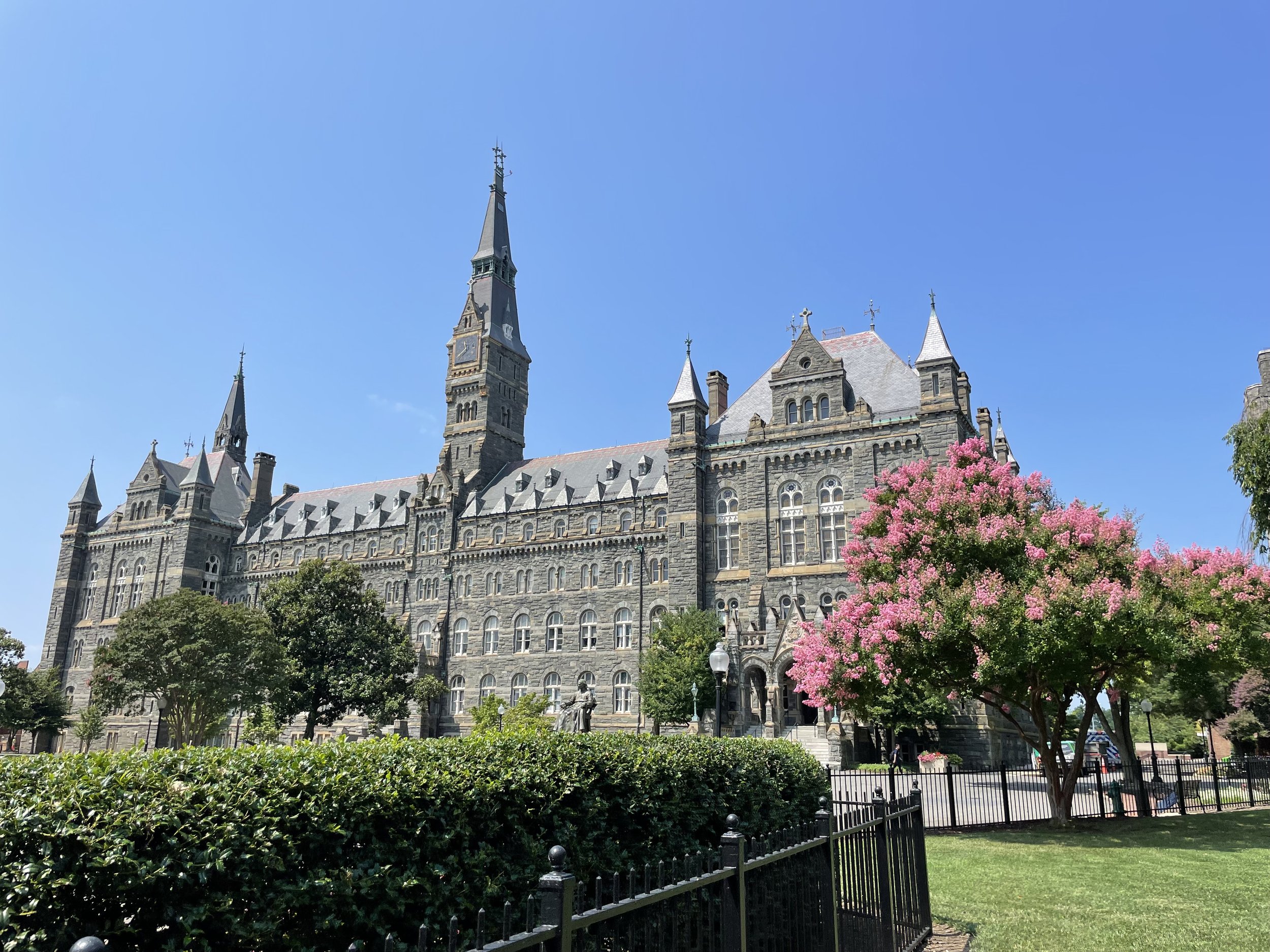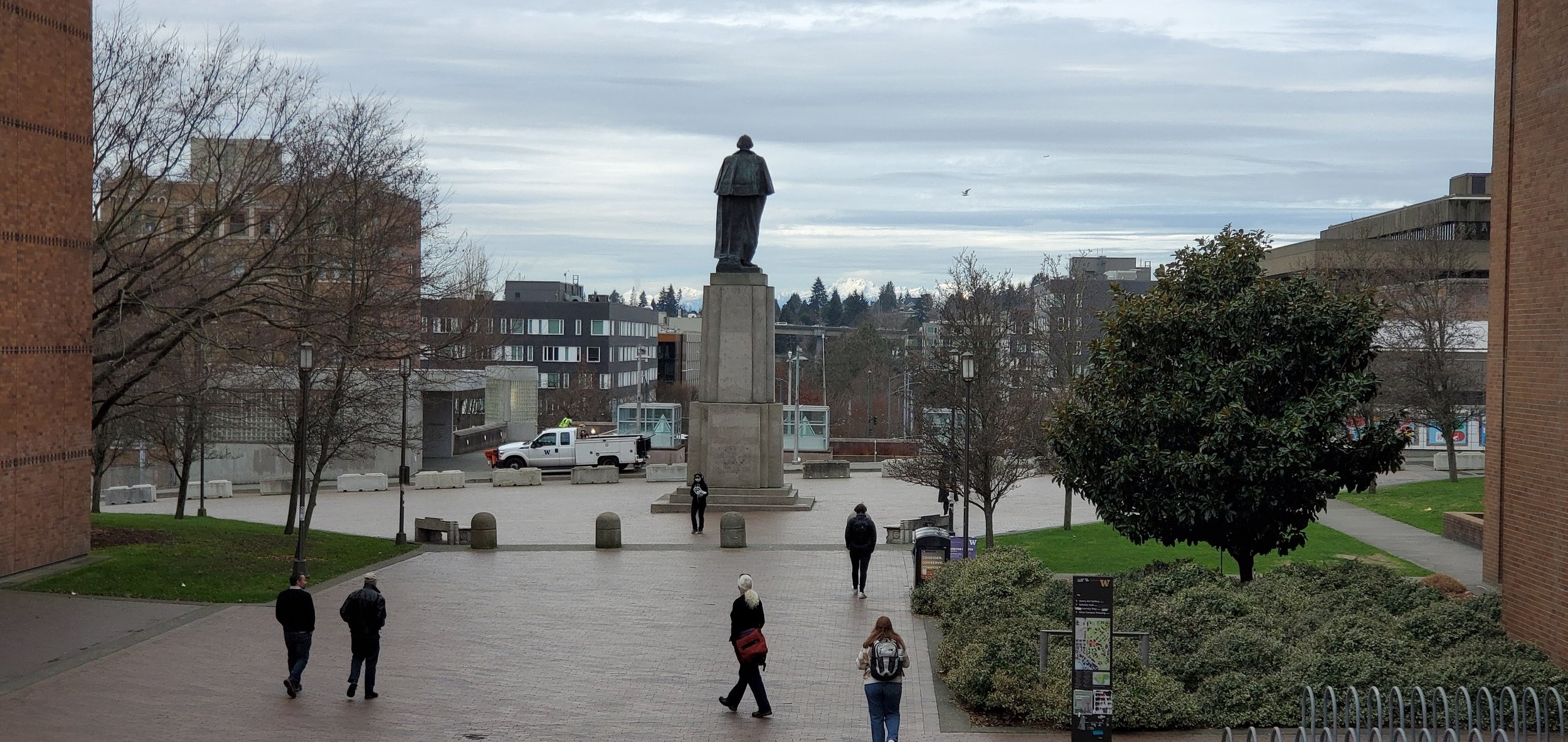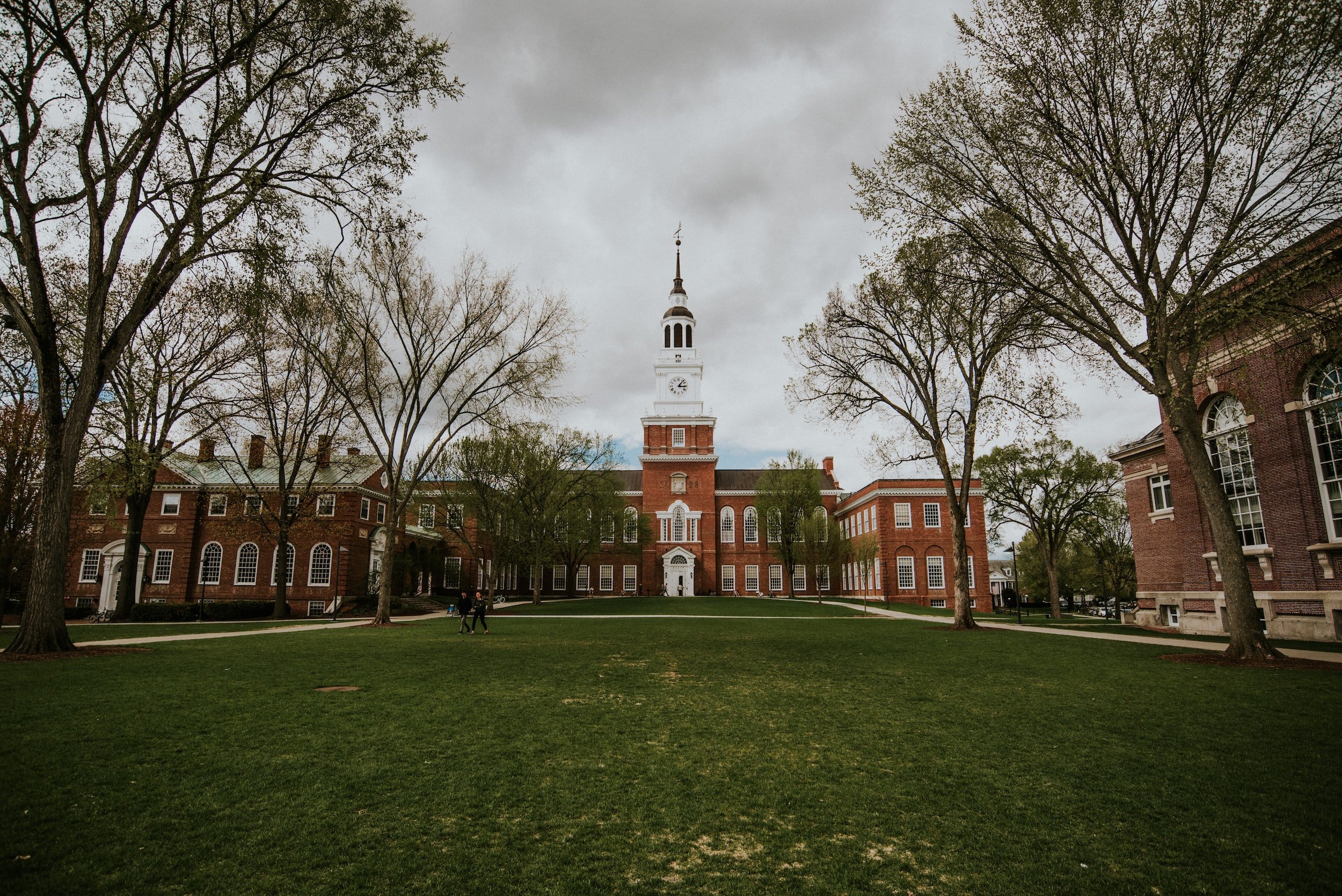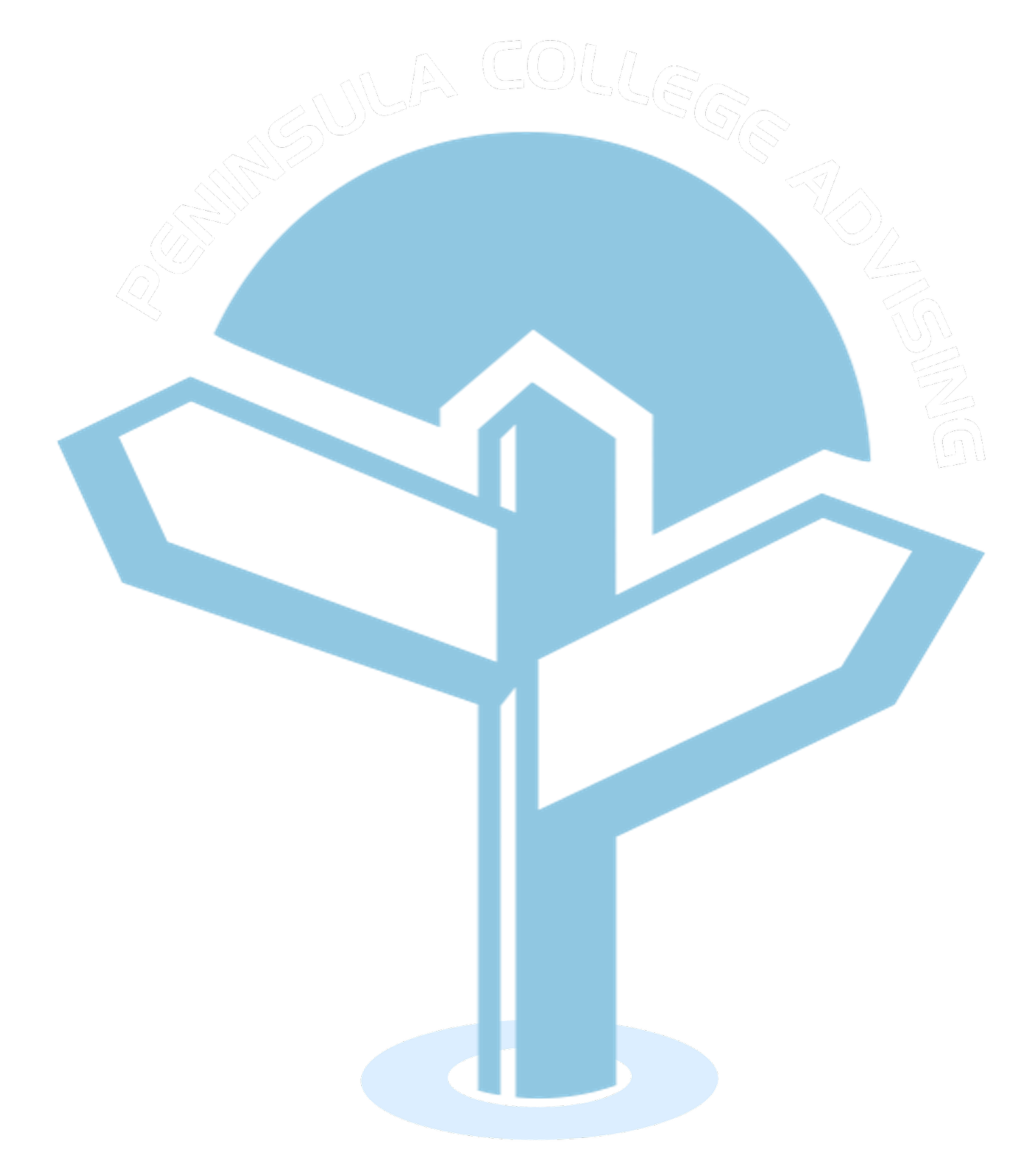SIGNPOST BLOG

Visit to Georgetown University
Recently, I attended an information session and toured the beautiful campus of Georgetown University—on an extremely hot summer day. I took a Lyft ride to the gates and walked the short distance to the admissions office in an imposing stone building. Students and their families thronged into the small space so we were led in batches to a large auditorium. The admissions officer said over 250 people would visit that day. Georgetown is clearly a “hot” school weather-wise and n terms of popularity.
Waiting for our information session we viewed a slide show featuring photos of the campus and students: cherry blossoms, Federal style architecture, the campus in different seasons, international flags, photos of diverse groups of students, colorful row houses, shops and restaurants in the local neighborhood, and only one photo of a chapel service, which seemed to underplay the importance of religion at this Jesuit university.
But during the information presentation itself, the admissions officer stressed the university’s founding and history by Jesuit John Carroll in 1789 and its enduring Jesuit values. Georgetown’s seal that features an eagle (for our nation), a globe (for its international focus) and a cross (for its Catholic founding).
And the university’s mission/goals also reinforce Jesuit values:
1. Men and women for others (service)
2. Cura Personalis: care of the whole person (holistic learning, intellectual curiosity)
3. Inter-religious understand (Carroll founded the university as a pluralist institution to welcome students of all faiths.)
Today of the 7,000 undergraduate students, between 30% and 50% of students identify as Catholic.
Here’s a summary of what I learned both from the admissions officer and our student tour guide, who led us on an abbreviated circuit around the campus, hugging the shade (luckily, there are many mature trees across the grounds).
Academics
--5 undergraduate colleges:
1. Arts and Sciences (largest school containing humanities, social sciences and natural sciences)
2. Nursing (1 major)
3. Health (3 undergraduate majors in global health, health policy and human science)
4. School of Foreign Service
5. School of Business
--Double majors are not permitted across schools but a student can minor in a different school.
--3 joint degrees are offered: business and international affairs, international business language and culture, and a new public policy degree offered in conjunction with the graduate school
Georgetown’s core curriculum includes 2 religion courses, not necessarily Christian; all freshmen take "Problem of God" seminar
--A downtown satellite campus called "Capitol Applied Learning Labs" puts students in the heart of government, living and learning
The university offer the typical resources of a well endowed private university: faculty mentoring, research opportunities, great internships in the D.C. area.
Study abroad is quite popular: direct matriculation in foreign universities, also a program at Florence "villa"
Residential Life:
--3 year on campus living requirement; excellent dorms
--60% of seniors live off campus
--more than 300 clubs
--quaint neighborhood, college town feel with restaurants, coffee shops, bars, etc.
--US capitol less than 3 miles away
--No official Greek life
--Clubs offer social life
Applications/Admissions
Georgetown not on the Common Application; instead applicants complete a separate 2 part application.
--Applicants need to send in part one to receive supplement with 2 essays: tell us about yourself, interest in a specific college/program
--SAT/ACT score required!
--An interview with a Georgetown alumnus is an important part of the application evaluation (different from other selective universities).
--There is no statistical advantage in applying EA (13% vs. 12% acceptance rate.)
--A student can't apply EA if applying REA or ED elsewhere.



Urban Campuses
Our family just spent a week in New York City and we had the opportunity to visit both NYU and Columbia—where we also attended an information session and college tour. Walking through these campuses reminded me of some of the benefits and drawbacks of attending an urban university.
I was a graduate student at Columbia in the ancient 1980s and while the neighborhood has certainly improved since then, I was reminded of how I sometimes felt “lonely in a crowd” while living in a big city. Undergraduates and graduates have different experiences, especially socially, but I do believe students who want to attend urban schools need to be aware of salient features of urban college life.
NYU occupies a good chunk of the Greenwich Village neighborhood of lower Manhattan. University buildings are marked by large purple flags and they are generally within close walking proximity of one another. There is no true “campus” at NYU, however. Washington Square Park really functions as its hub. The whole area is rich in culture and history, particularly of the arts and politics. There are great coffee shops, funky art and apparel shops, and clubs and cafes where students abound. At the Visitor’s Center we found a plethora of publications describing the universities programs in the humanities, sciences, business, and health and human services. NYU has also developed innovative study abroad programs in Europe, Latin America, Australia and Israel and two other “campuses” or “global academic centers” in Abu Dhabi and Shanghai. Walking around the Village we felt an exciting vibe, but it was not primarily due to the students themselves or anything directly related to undergraduate life.
Columbia, in contrast, owns a large acreage in the Upper West Side area of Manhattan, a neighborhood called Morningside Heights. There is a gate to enter the campus on Broadway and a true quad inside containing most of the academic buildings, Butler Library, and the freshman dormitories. Yes, the campus is condensed and miniature compared to sprawling campuses like Stanford or Duke, but there is an identifiable center or home for undergraduate life. During the tour, our guide Andrew explained that the university has built a second campus to house more of the graduate programs elsewhere so that undergraduates will dominate the Morningside Campus even more in subsequent years.
Like all tour guides, he praised his own college’s curriculum, particularly Columbia’s famous “core,” but he also emphasized the opportunities he has to obtain real-life work experience in NYC while completing his undergraduate coursework. He doesn’t have to take time off toe seek an internship elsewhere because the city is literally at his doorstep.
So it seems to me that urban schools have the advantage of not being too separate from “real” life—and the disadvantage, too. Many students may prefer to have their undergraduate years a bit “apart” from the hustle and bustle of our commercial world. An on-campus life may allow more time for conversations about courses and common experiences, for interaction with faculty, for building friendships with fellow students without the distraction of broader social and economic opportunity. Of course there is no right and wrong here, only preference. For myself, I’m glad I attended an undergraduate institution that had a strong campus identity. I was ready for the big city a few years later. Other students have already outgrown their suburban lifestyles and are eager for the chance to explore both a new campus and a new city.



